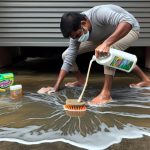To quickly get rid of polypropylene odor from fabric, start by ventilating the item and spot-treating with a vinegar and water mix. Then, apply baking soda to stubborn areas before washing with a mild, synthetic-friendly detergent in warm water. Add a cup of vinegar during the rinse for extra odor neutralization. Air-dry in a well-ventilated spot to avoid setting smells. If you want to keep your fabric fresh longer and explore other effective tricks, there’s more to discover.
Table of Contents
Key Takeaways
- Ventilate polypropylene fabric outdoors to reduce odor intensity before washing.
- Pre-treat stains with a vinegar and water solution, letting it sit for 10-15 minutes.
- Wash fabric in warm water with synthetic-friendly detergent and add white vinegar during rinse.
- Air dry fabric in a well-ventilated area to naturally dissipate odors and prevent heat setting.
- Use baking soda paste on odor spots for 30 minutes and sprinkle baking soda between uses.
Understanding the Source of Polypropylene Odor
Although polypropylene is known for its durability and resistance to chemicals, you might notice an unpleasant odor coming from fabrics made with this material. That smell usually comes from the manufacturing process, where certain chemicals and additives are used. These substances can linger in the fibers, especially if the fabric hasn’t been washed thoroughly.
Additionally, polypropylene is hydrophobic, meaning it repels water, which makes it harder for odors to wash out easily. When sweat, oils, or bacteria get trapped in the fabric, the odor can intensify.
Understanding that the odor isn’t just from dirt but from residual chemicals and trapped moisture helps you tackle it more effectively. Recognizing these factors sets a solid foundation for eliminating the smell from your polypropylene fabrics.
Pre-Treatment Steps Before Washing
Before washing, you’ll want to ventilate your fabric thoroughly to help reduce the odor.
Next, spot clean stubborn areas with vinegar to break down the smell.
Finally, apply a baking soda paste to neutralize any lingering odors before the full wash.
Ventilate Fabric Thoroughly
Since polypropylene fabric tends to trap odors, you should start by airing it out in a well-ventilated space.
Hang the fabric outdoors if possible, where fresh air can circulate freely around it. If outdoor airing isn’t an option, place it near an open window or use a fan to promote airflow indoors.
Make sure the fabric isn’t folded or bunched up, as this can trap smells instead of letting them escape. The goal is to expose as much surface area as possible to fresh air.
Ventilating thoroughly helps reduce the intensity of the odor before you proceed with washing. This simple step often makes a noticeable difference, improving how well subsequent cleaning treatments work to eliminate stubborn polypropylene smells.
Spot Clean With Vinegar
When you notice stubborn odors lingering on your polypropylene fabric, spot cleaning with vinegar can help break down the smell before you wash.
Start by mixing equal parts white vinegar and water in a spray bottle. Lightly spray the affected areas without soaking the fabric. Let the vinegar solution sit for about 10 to 15 minutes to penetrate and neutralize odor-causing molecules.
Afterward, blot the area gently with a clean cloth to lift away the vinegar and trapped odors. This pre-treatment targets odor hotspots effectively, preparing your fabric for a more thorough wash.
Vinegar’s natural acidity helps eliminate smells without damaging polypropylene fibers, making it a safe, eco-friendly choice for odor removal.
Use Baking Soda Paste
If vinegar doesn’t fully tackle the odor, you can turn to baking soda paste for a stronger pre-wash treatment.
Mix baking soda with a little water to create a thick paste. Apply this paste directly onto the smelly areas of the fabric, gently rubbing it in with your fingers or a soft brush.
Baking soda works by neutralizing odors and absorbing moisture, making it ideal for stubborn polypropylene smells.
Let the paste sit on the fabric for at least 30 minutes, or longer if the smell is particularly strong.
Afterward, rinse off the paste with cool water before tossing the fabric into the washing machine.
This pre-treatment will enhance your chances of completely eliminating the odor and leaving your polypropylene fabric fresh.
Using Vinegar to Neutralize Odors
Although polypropylene can hold stubborn odors, you can effectively neutralize them using vinegar. Vinegar’s acetic acid breaks down odor-causing compounds, leaving your fabric fresher without harsh chemicals.
To use, mix equal parts white vinegar and water, then soak or spray your fabric. Let it sit for about 30 minutes before rinsing thoroughly.
Keep these tips in mind when using vinegar:
- Test on a small fabric area first to avoid discoloration.
- Avoid mixing vinegar with bleach or ammonia, as this creates harmful fumes.
- Air dry your fabric after treatment to allow any residual smell to dissipate naturally.
This simple, natural method is quick and eco-friendly, making vinegar a great choice for odor removal from polypropylene fabrics.
Baking Soda Soak for Deep Odor Removal
You’ll want to start by mixing a generous amount of baking soda into warm water to create a soaking solution.
Let your fabric soak for at least a few hours to help break down stubborn odors.
After soaking, rinse and air dry the fabric to keep it fresh and odor-free.
Preparing Baking Soda Solution
Start by mixing four tablespoons of baking soda into a quart of warm water to create an effective soaking solution.
Stir well until the baking soda dissolves completely, ensuring an even distribution of odor-neutralizing power. Use warm water, not hot, to avoid damaging the fabric fibers.
Keep these tips in mind:
- Use a non-metal container to prevent any reaction with baking soda.
- Prepare the solution fresh for each use to maintain its effectiveness.
- Adjust the quantity based on the size of the fabric and container you’re using.
This simple preparation is essential for successfully removing polypropylene odors, as the baking soda solution penetrates deeply to neutralize smells without harsh chemicals.
Soaking Duration Tips
When you soak fabric in the baking soda solution, allowing enough time for it to absorb is key to eliminating polypropylene odors effectively.
For light odors, soaking for 30 minutes usually works well. However, when dealing with stronger or more persistent smells, extend the soak to at least two hours.
If the odor is particularly stubborn, an overnight soak can make a significant difference. Just make certain the fabric is fully submerged and occasionally stir the solution to guarantee even exposure.
Avoid soaking longer than 24 hours to prevent fabric damage. By adjusting the soaking time based on odor intensity, you’ll boost the baking soda’s ability to neutralize unpleasant smells deeply and efficiently.
Post-Soak Fabric Care
Although the baking soda soak removes much of the polypropylene odor, proper post-soak care guarantees your fabric stays fresh and undamaged.
Once you’ve soaked your fabric, rinse it thoroughly with cold water to remove any leftover baking soda residue. Avoid wringing the fabric; instead, gently press out excess water to protect the fibers.
Finally, air dry your fabric in a well-ventilated area, preferably outdoors, to help dissipate any lingering odors naturally.
- Rinse thoroughly to prevent residue buildup.
- Handle fabric gently to avoid stretching or damage.
- Air dry in fresh air to neutralize remaining odors.
Following these steps assures your fabric retains its quality and stays odor-free after the baking soda soak.
Choosing the Right Detergent for Polypropylene
Because polypropylene fabrics tend to trap odors, you’ll need a detergent specifically designed to break down oils and bacteria without damaging the material.
Look for detergents labeled as enzymatic or formulated for synthetic fabrics, as they target odor-causing compounds effectively. Avoid harsh chemicals or bleach, which can degrade polypropylene fibers and worsen odors.
Choose enzymatic or synthetic fabric detergents to fight odors; avoid bleach to protect polypropylene fibers.
Liquid detergents often work better than powders because they dissolve more easily and penetrate the fabric thoroughly. You might also consider detergents with added odor eliminators or antibacterial agents to enhance freshness.
Always check the detergent’s instructions and compatibility with synthetic materials to prevent damage. Choosing the right detergent sets the foundation for odor removal, so pick one that’s tough on smells but gentle on your polypropylene fabric.
Optimal Washing Techniques and Water Temperature
To effectively remove odors from polypropylene fabric, you should use the right washing techniques combined with an appropriate water temperature.
Start by washing the fabric in warm water, around 40°C (104°F), which helps dissolve odor-causing oils without damaging the fibers. Avoid hot water, as it can set odors or shrink the fabric.
Use a gentle cycle to prevent wear and tear while guaranteeing thorough cleaning. If odors persist, add a cup of white vinegar during the rinse cycle to neutralize smells naturally.
- Use warm water to balance odor removal and fabric care
- Select a gentle wash cycle to protect fabric integrity
- Incorporate natural deodorizers like vinegar for enhanced freshness
These steps guarantee you tackle odors effectively while maintaining your polypropylene fabric’s quality.
Air Drying vs. Machine Drying: What Works Best
When deciding how to dry your polypropylene fabric, you might wonder whether air drying or machine drying works best.
Air drying is gentle and helps prevent heat damage, which can trap odors in the fibers if you’re not careful. Letting your fabric dry in fresh air also allows lingering smells to dissipate naturally.
On the other hand, machine drying can speed up the process, but high heat might set any remaining odors permanently. If you choose machine drying, use a low heat setting to avoid this risk.
Using Activated Charcoal to Absorb Residual Smells
Although washing and drying help reduce odors, you might still notice lingering smells in your polypropylene fabric. Activated charcoal is a powerful tool to absorb these stubborn odors quickly. You can place small sachets or bowls filled with activated charcoal near or inside the fabric storage area. The porous nature of charcoal traps odor molecules effectively, leaving your fabric smelling fresh.
Activated charcoal effectively absorbs stubborn odors from polypropylene fabric, leaving it fresh and odor-free.
To maximize the benefits, consider these tips:
- Use fresh, unused activated charcoal for better absorption.
- Keep charcoal sachets close to the fabric but avoid direct contact to prevent mess.
- Replace or recharge the charcoal every few weeks to maintain effectiveness.
With this simple step, you can effectively tackle residual polypropylene odors and restore your fabric’s freshness.
Preventative Measures to Keep Polypropylene Fresh Longer
Activated charcoal can help eliminate lingering odors, but preventing those smells from developing in the first place saves you time and effort.
To keep your polypropylene fabric fresh longer, start by washing it regularly with a mild detergent designed for synthetic materials. Avoid using fabric softeners, which can trap odors.
After washing, dry the fabric thoroughly in fresh air or a well-ventilated area to prevent moisture buildup, a common cause of odor. Store polypropylene items in cool, dry places away from direct sunlight to reduce odor-causing bacteria growth.
You can also sprinkle baking soda on the fabric between uses to absorb any emerging smells. By following these simple steps, you’ll maintain your polypropylene’s freshness and avoid the hassle of dealing with stubborn odors later.
Frequently Asked Questions
Can Polypropylene Odor Cause Allergic Reactions or Health Issues?
You might experience allergic reactions or health issues from polypropylene odor, especially if you’re sensitive. The fumes can irritate your eyes, nose, or throat, so it’s best to ventilate the area and avoid prolonged exposure.
Is It Safe to Use Bleach on Polypropylene Fabric to Remove Odors?
Wondering if bleach is a safe hero for your polypropylene fabric? You shouldn’t use it, as bleach can damage the fibers. Instead, opt for gentle detergents or vinegar to tackle odors without ruining your fabric’s integrity.
How Long Does It Typically Take for Polypropylene Odor to Dissipate Naturally?
You’ll usually find polypropylene odor fades naturally within a few days to a couple of weeks, depending on airflow and exposure to sunlight. You can speed this up by airing out the fabric regularly and keeping it dry.
Can Professional Dry Cleaning Effectively Remove Polypropylene Odors?
Coincidentally, you might wonder if professional dry cleaning can handle stubborn odors. It often does a good job removing polypropylene smells, but results vary. You should check with your cleaner to verify they’re equipped for it.
Does Polypropylene Odor Affect the Fabric’s Durability or Texture Over Time?
You won’t notice polypropylene odor affecting your fabric’s durability or texture over time. The smell doesn’t degrade the material; instead, focus on proper cleaning to keep your fabric fresh and maintain its original quality.
- Tetron Fabric for Marine Applications: Durability and Use Cases - June 18, 2025
- Tetron Fabric for Outdoor Furniture: Weather Resistance and Care - June 18, 2025
- Tetron Fabric for Wall Coverings: Style and Application Tips - June 18, 2025






